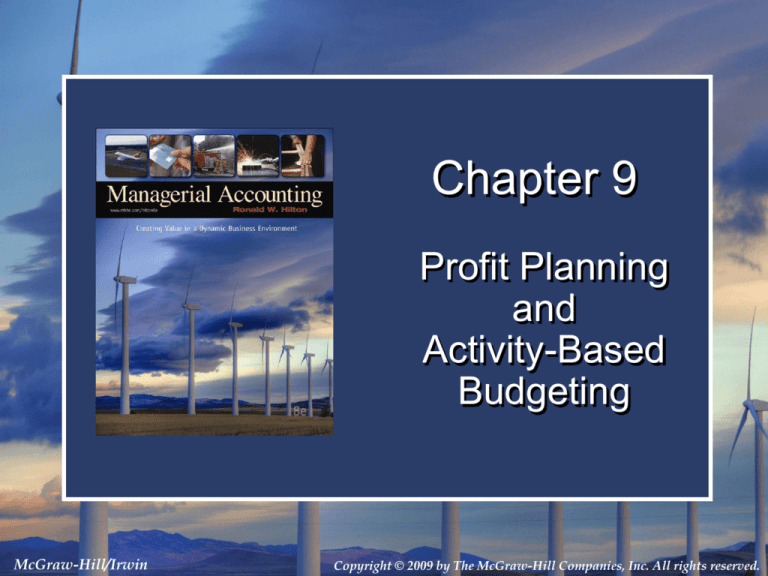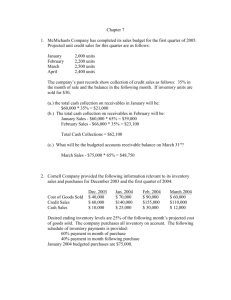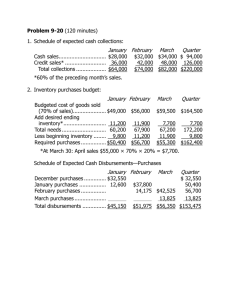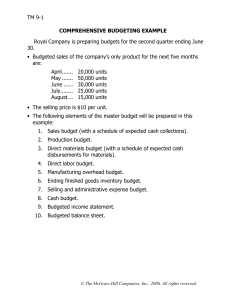
Chapter 9
Profit Planning
and
Activity-Based
Budgeting
McGraw-Hill/Irwin
Copyright © 2009 by The McGraw-Hill Companies, Inc. All rights reserved.
Learning
Objective
1
McGraw-Hill/Irwin
Copyright © 2009 by The McGraw-Hill Companies, Inc. All rights reserved.
Purposes of Budgeting Systems
Budget
a detailed plan,
expressed in
quantitative terms,
that specifies how
resources will be
acquired and used
during a specified
period of time.
1. Planning
2. Facilitating
Communication and
Coordination
3. Allocating Resources
4. Controlling Profit and
Operations
5. Evaluating
Performance and
Providing Incentives
9-3
Types of Budgets
Detail
Budget
Detail
Budget
Covering all
phases of
a company’s
operations.
Production
Master
Budget
Detail
Budget
9-4
Types of Budgets
Income
Statement
Budgeted
Financial
Statements
Balance
Sheet
Statement of
Cash Flows
9-5
Types of Budgets
Capital budgets with acquisitions
that normally cover several years.
Financial budgets with financial
resource acquisitions.
Long Range Budgets
Continuous or
1999Rolling Budget 2000
2001
2002
This budget is usually a twelve-month
budget that rolls forward one month
as the current month is completed.
9-6
Learning
Objective
2
McGraw-Hill/Irwin
Copyright © 2009 by The McGraw-Hill Companies, Inc. All rights reserved.
Sales of Services or Goods
Ending
Inventory
Budget
Production
Budget
Work in Process
and Finished
Goods
Ending
Inventory
Budget
Direct
Materials
Budget
Direct
Labor
Budget
Overhead
Budget
Direct Materials
Cash Budget
Selling and
Administrative
Budget
Budgeted Income
Statement
Budgeted Balance
Sheet
Budgeted Statement
of Cash Flows
9-8
Learning
Objective
3
McGraw-Hill/Irwin
Copyright © 2009 by The McGraw-Hill Companies, Inc. All rights reserved.
Activity-Based Costing versus
Activity-Based Budgeting
Resources
Resources
Activity-Based
Costing (ABC)
Activities
Cost objects:
products and services
produced, and
customers served.
Activities
Activity-Based
Budgeting (ABB)
Forecast of products
and services to be
produced and
customers served.
9-10
Learning
Objective
4
McGraw-Hill/Irwin
Copyright © 2009 by The McGraw-Hill Companies, Inc. All rights reserved.
Sales Budget
Breakers, Inc. is preparing budgets for the quarter
ending June 30.
Budgeted sales for the next five months are:
April
20,000 units
May
50,000 units
June
30,000 units
July
25,000 units
August
15,000 units.
The selling price is $10 per unit.
9-12
Sales Budget
April
Budgeted
sales (units)
20,000
Selling price
per unit
$
10
Total
Revenue
$ 200,000
May
June
50,000
$
10
$ 500,000
Quarter
30,000
$
10
$ 300,000
100,000
$
10
$ 1,000,000
9-13
Production Budget
The management of Breakers, Inc. wants ending
inventory to be equal to 20% of the following
month’s budgeted sales in units.
On March 31, 4,000 units were on hand.
Let’s prepare the production budget.
9-14
From
sales
budget
Sales in units
Add: desired
end. inventory
Total needed
Less: beg.
inventory
Units to be
produced
Production Budget
April
20,000
10,000
30,000
May sales
50,000 units
Desired percent
20%
May
June
Quarter
Desired inventory
10,000 units
50,000
30,000
100,000
Ending inventory becomes
6,000beginning 5,000
5,000
inventory the next
56,000
35,000
105,000
month
4,000
10,000
6,000
4,000
26,000
46,000
29,000
101,000
March 31
ending inventory
9-15
Direct-Material Budget
• At Breakers, five pounds of material are required
per unit of product.
• Management wants materials on hand at the end
of each month equal to 10% of the following
month’s production.
• On March 31, 13,000 pounds of material are on
hand. Material cost $.40 per pound.
Let’s prepare the direct materials budget.
9-16
From our
production
budget
Direct-Material Budget
Production in units
Materials per unit
Production needs
Add: desired
ending inventory
Total needed
Less: beginning
inventory
Materials to be
purchased
April
26,000
5
130,000
May
46,000
5
230,000
June
29,000
5
145,000
Quarter
101,000
5
505,000
23,000
153,000
14,500
244,500
11,500
156,500
11,500
516,500
13,000
23,000
14,500
13,000
140,000
221,500
142,000
503,500
10% of the following
month’s production
March 31
inventory
9-17
Direct-Material Budget
July Production
April 25,000 May
Sales in units
Add: Production
desired ending
inventory26,000 3,000 46,000
in units
TotalMaterials
units needed
per unit
528,000
5
Less:Production
beginning inventory
needs
130,000 5,000 230,000
Production in units
23,000
June
29,000
5
145,000
Add: desired
ending inventory
23,000
14,500
11,500
Total needed
153,000
244,500
156,500
Less: beginning
June
Ending Inventory
inventory
13,000
23,000
14,500
July
in units
23,000
Materials
toproduction
be
Materials per unit
5142,000
purchased
140,000
221,500
Total units needed
115,000
Inventory percentage
10%
June desired ending inventory
11,500
Quarter
101,000
5
505,000
11,500
516,500
13,000
503,500
9-18
Direct-Labor Budget
• At Breakers, each unit of product requires 0.1 hours
of direct labor.
• The Company has a “no layoff” policy so all
employees will be paid for 40 hours of work each
week.
• In exchange for the “no layoff” policy, workers agreed
to a wage rate of $8 per hour regardless of the hours
worked (No overtime pay).
• For the next three months, the direct labor workforce
will be paid for a minimum of 3,000 hours per month.
Let’s prepare the direct labor budget.
9-19
Direct-Labor Budget
April
26,000
0.10
2,600
Production in units
Direct labor hours
Labor hours required
Guaranteed labor
hours
3,000
Labor hours paid
3,000
Wage rate
$
8
Total direct labot cost $ 24,000
From our
production
budget
May
46,000
0.10
4,600
June
29,000
0.10
2,900
Quarter
101,000
0.10
10,100
3,000
4,600
$
8
$ 36,800
3,000
3,000
$
8
$ 24,000
10,600
$
8
$ 84,800
This is the greater of
labor hours required or
labor hours guaranteed.
9-20
Overhead Budget
Here is Breakers’ Overhead Budget for the quarter.
April
Indirect labor
Indirect material
Utilities
Rent
Insurance
Maintenance
$
$
17,500
7,000
4,200
13,300
5,800
8,200
56,000
May
$
$
26,500
12,600
8,400
13,300
5,800
9,400
76,000
June
$
$
17,900
8,600
5,200
13,300
5,800
8,200
59,000
Quarter
$
61,900
28,200
17,800
39,900
17,400
25,800
$ 191,000
9-21
Selling and Administrative
Expense Budget
• At Breakers, variable selling and administrative
expenses are $0.50 per unit sold.
• Fixed selling and administrative expenses are
$70,000 per month.
• The $70,000 fixed expenses include $10,000 in
depreciation expense that does not require a cash
outflows for the month.
9-22
Selling and Administrative
Expense Budget
Sales in units
Variable S&A rate
Variable expense
Fixed S&A
expense
Total expense
Less: noncash
expenses
Cash
disbursements
April
20,000
$ 0.50
$ 10,000
May
50,000
$ 0.50
$ 25,000
June
30,000
$ 0.50
$ 15,000
Quarter
100,000
$
0.50
$ 50,000
70,000
80,000
70,000
95,000
70,000
85,000
210,000
260,000
10,000
10,000
10,000
30,000
$ 70,000
$ 85,000
$ 75,000
$ 230,000
From our
Sales budget
9-23
Cash Receipts Budget
• At Breakers, all sales are on account.
• The company’s collection pattern is:
70% collected in the month of sale,
25% collected in the month following sale,
5% is uncollected.
• The March 31 accounts receivable balance of
$30,000 will be collected in full.
9-24
Cash Receipts Budget
Accounts rec. - 3/31
April sales
70% x $200,000
25% x $200,000
May sales
70% x $500,000
25% x $500,000
June sales
70% x $300,000
Total cash collections
April
$ 30,000
May
June
140,000
140,000
50,000
$ 50,000
350,000
$ 170,000
$ 400,000
Quarter
$ 30,000
$ 125,000
350,000
125,000
210,000
$ 335,000
210,000
$ 905,000
9-25
Cash Disbursement Budget
• Breakers pays $0.40 per pound for its materials.
• One-half of a month’s purchases are paid for in the
month of purchase; the other half is paid in the
following month.
• No discounts are available.
• The March 31 accounts payable balance is
$12,000.
9-26
Cash Disbursement Budget
Accounts pay. 3/31
April purchases
50% x $56,000
50% x $56,000
May purchases
50% x $88,600
50% x $88,600
June purchases
50% x $56,800
Total cash payments
for materials
April
$ 12,000
May
June
28,000
28,000
28,000
$ 28,000
44,300
$ 40,000
$ 72,300
Quarter
$ 12,000
$ 44,300
44,300
44,300
28,400
28,400
$ 72,700
$ 185,000
140,000 lbs. × $.40/lb. = $56,000
9-27
Cash Disbursement Budget
Breakers:
– Maintains a 12% open line of credit for $75,000.
– Maintains a minimum cash balance of $30,000.
– Borrows and repays loans on the last day of the
month.
– Pays a cash dividend of $25,000 in April.
– Purchases $143,700 of equipment in May and
$48,300 in June paid in cash.
– Has an April 1 cash balance of $40,000.
9-28
From our Cash
Receipts Budget
Cash Budget
(Collections and Disbursements)
April
Beginning cash balance $ 40,000
Add: cash collections
170,000
Total cash available
210,000
Less: disbursements
Materials
40,000
Direct labor
24,000
Mfg. overhead
56,000
Selling and admin.
70,000
Equipment purchase
Dividends
25,000
Total disbursements
215,000
Excess (deficiency) of
Cash available over
disbursements
$ (5,000)
May
June
Quarter
From our Cash Disbursements
Budget
From our Direct Labor Budget
From our Overhead Budget
From our Selling and
Administrative Expense
Budget
To maintain a cash
balance of $30,000,
Breakers must borrow
$35,000 on its line of credit.
9-29
Cash Budget
(Collections and Disbursements)
April
Beginning cash balance $ 40,000
Add: cash collections
170,000
Total cash available
210,000
Less: disbursements
Materials
40,000
Direct labor
24,000
Mfg. overhead
56,000
Selling and admin.
70,000
Equipment purchase
Dividends
25,000
Total disbursements
215,000
Excess (deficiency) of
Cash available over
disbursements
$ (5,000)
May
$ 30,000
400,000
430,000
72,300
36,800
76,000
85,000
143,700
413,800
June
Quarter
Breakers must
borrow an
addition $13,800
to maintain a
cash balance
of $30,000.
$ 16,200
9-30
Cash Budget
(Collections and Disbursements)
April
May
Beginning
$ 40,000
At thecash
endbalance
of June,
Breakers$ 30,000
Add: cash collections
has enough cash170,000
to repay 400,000
Total cash available
210,000
430,000
the $48,800 loan plus interest
Less: disbursements
at 12%. 40,000
Materials
72,300
Direct labor
24,000
36,800
Mfg. overhead
56,000
76,000
Selling and admin.
70,000
85,000
Equipment purchase
143,700
Dividends
25,000
Total disbursements
215,000
413,800
Excess (deficiency) of
Cash available over
disbursements
$ (5,000)
$ 16,200
June
$ 30,000
335,000
365,000
Quarter
72,700
24,000
59,000
75,000
48,300
279,000
$ 86,000
9-31
Cash Budget
(Collections and Disbursements)
April
Beginning cash balance $ 40,000
Add: cash collections
170,000
Total cash available
210,000
Less: disbursements
Materials
40,000
Direct labor
24,000
Mfg. overhead
56,000
Selling and admin.
70,000
Equipment purchase
Dividends
25,000
Total disbursements
215,000
Excess (deficiency) of
Cash available over
disbursements
$ (5,000)
May
$ 30,000
400,000
430,000
June
$ 30,000
335,000
365,000
Quarter
$ 40,000
905,000
945,000
72,300
36,800
76,000
85,000
143,700
413,800
72,700
24,000
59,000
75,000
48,300
279,000
185,000
84,800
191,000
230,000
192,000
25,000
907,800
$ 16,200
$ 86,000
$ 37,200
9-32
Ending cash
balance for April
is the beginning
May balance.
Cash Budget
(Financing and Repayment)
Excess (deficiency) of
Cash available over
disbursements
Financing:
Borrowing
Repayments
Interest
Total financing
Ending cash balance
Borrowing
$
35,000
13,800
×
×
April
May
June
Quarter
$ (5,000)
$ 16,200
$ 86,000
$ 37,200
35,000
35,000
$ 30,000
13,800
13,800
$ 30,000
(48,800)
(838)
(49,638)
$ 36,362
48,800
(48,800)
(838)
(838)
$ 36,362
Rate
12% =
12% =
Annual
Interest
$
4,200
1,656
Months
Outstanding
×
2 mths
=
×
1 mth.
=
Interest
Expense
$
700
138
$
838
9-33
Cost of Goods Manufactured
April
Direct material:
Beg.material inventory
$ 5,200
Add: Materials purchases
56,000
Material available for use
61,200
Deduct: End. material inventory
9,200
Direct material used
52,000
Direct labor
24,000
Manufacturing overhead
56,000
Total manufacturing costs
132,000
Add: Beg. Work-in-process inventory
3,800
Subtotal
135,800
Deduct: End.Work-in-process inventory
16,200
Cost of goods manufactured
$ 119,600
May
$
9,200
88,600
97,800
5,800
92,000
36,800
76,000
204,800
16,200
221,000
9,400
$ 211,600
June
$
5,800
56,800
62,600
4,600
58,000
24,000
59,000
141,000
9,400
150,400
17,000
$ 133,400
Quarter
$
5,200
201,400
206,600
4,600
202,000
84,800
191,000
477,800
3,800
481,600
17,000
$ 464,600
9-34
Cost of Goods Sold
Cost of goods manufactured
Add: Beg. finished-goods inventory
Cost of goods available for sale
Deduct: End. finished-goods inventory
Cost of goods sold
April
May
$ 119,600 $ 211,600 $
18,400
46,000
138,000
257,600
46,000
27,600
$ 92,000 $ 230,000 $
June
Quarter
133,400 $ 464,600
27,600
18,400
161,000
483,000
23,000
23,000
138,000 $ 460,000
9-35
Budgeted Income Statement
Breakers, Inc.
Budgeted Income Statement
For the Three Months Ended June 30
Revenue (100,000 × $10)
Cost of goods sold
Gross margin
Operating expenses:
Selling and admin. expenses
Interest expense
Total operating expenses
Net income
$ 1,000,000
460,000
540,000
$ 260,000
838
$
260,838
279,162
9-36
Budgeted Statement of Cash Flows
April
May
Cash flows from operating activities:
Cash receipts from customers
$ 170,000 $
Cash payments:
To suppliers of raw material
(40,000)
For direct labor
(24,000)
For manufacturing-overhead expenditures
(56,000)
For selling and administrative expenses
(70,000)
For interest
Total cash payments
(190,000)
Net cash flow from operating activities
Cash flows from investing activities:
Purchase of equipment
$
Net cash used by investing activities
Cash flows from financing activities:
Payment of dividends
Principle of bank loan
Repayment of bank loan
$
Net cash provided by financing activities
$
Net increase in cash
Balance in cash, beginning
Balance in cash. end of month
(20,000) $
-
Quarter
400,000 $
335,000 $
(72,300)
(36,800)
(76,000)
(85,000)
-
(72,700)
(24,000)
(59,000)
(75,000)
(838)
(185,000)
(84,800)
(191,000)
(230,000)
(838)
(270,100)
(231,538)
(691,638)
129,900 $
(143,700)
- $ (143,700) $
(25,000)
35,000
-
June
103,462 $
905,000
213,362
(48,300)
(192,000)
(48,300) $
(192,000)
13,800
-
(48,800)
(25,000)
48,800
(48,800)
10,000 $
13,800 $
(48,800) $
$
(10,000) $
40,000
- $
30,000
6,362 $
30,000
(3,638)
40,000
$
30,000 $
30,000 $
36,362 $
36,362
-
9-37
Budgeted Balance Sheet
Breakers reports the following account balances
on June 30 prior to preparing its budgeted
financial statements:
• Land - $50,000
• Building (net) - $148,000
• Common stock - $217,000
• Retained earnings - $46,400
9-38
25%of June
sales of
$300,000
11,500 lbs. at
$.40 per lb.
5,000 units at
$4.60 per unit.
50% of June
purchases
of $56,800
Beginning balance
Add: net income
Deduct: dividends
Ending balance
Breakers, Inc.
Budgeted Balance Sheet
June 30
Current assets
Cash
Accounts receivable
Raw materials inventory
Work-in-process inventory
Finished goods inventory
Total current assets
Property and equipment
Land
Building
Equipment
Total property and equipment
Total assets
$ 46,400
279,162 Accounts payable
(25,000) Common stock
$300,562 Retained earnings
Total liabilities and equities
$
$
$
$
36,362
75,000
4,600
17,000
23,000
155,962
50,000
148,000
192,000
390,000
545,962
28,400
217,000
300,562
545,962
9-39
Learning
Objective
5
McGraw-Hill/Irwin
Copyright © 2009 by The McGraw-Hill Companies, Inc. All rights reserved.
Sales of Services or Goods
Ending
Inventory
Budget
Production
Budget
Work in Process
and Finished
Goods
When the interactions of the elements
Ending
Direct budget
Directare expressedSelling
of the master
as and
Overhead
Inventory
Materials
Labor
Administrative
Budget
a
set
of
mathematical
relations,
it Budget
Budget
Budget
Budget
Direct Materials
becomes a financial planning model
that can be used to answer “what if”
Cash Budget
questions about unknown variables.
Budgeted Income
Statement
Budgeted Balance
Sheet
Budgeted Statement
of Cash Flows
9-41
Learning
Objective
6
McGraw-Hill/Irwin
Copyright © 2009 by The McGraw-Hill Companies, Inc. All rights reserved.
Budget Administration
The Budget Committee is a standing
committee responsible for . . .
overall policy matters relating to the budget.
coordinating the preparation of the budget.
9-43
International Aspects of Budgeting
Firms with international operations face special problems
when preparing a budget.
1. Fluctuations in foreign currency exchange
rates.
2. High inflation rates in some foreign countries.
3. Differences in local economic conditions.
9-44
Learning
Objective
7
McGraw-Hill/Irwin
Copyright © 2009 by The McGraw-Hill Companies, Inc. All rights reserved.
Budgeting Product Life-Cycle
Costs
Product planning
and concept
Design.
Distribution
and customer
service.
Preliminary
design.
Production.
Detailed design
and testing.
9-46
Learning
Objective
8
McGraw-Hill/Irwin
Copyright © 2009 by The McGraw-Hill Companies, Inc. All rights reserved.
Behavioral Impact of Budgets
Budgetary Slack: Padding the Budget
People often perceive that their performance will
look better in their superiors’ eyes if they can
“beat the budget.”
9-48
Participative Budgeting
Top Management
Middle
Management
Supervisor
Supervisor
Middle
Management
Supervisor
Supervisor
Flow of Budget Data
9-49
End of Chapter 9
9-50




